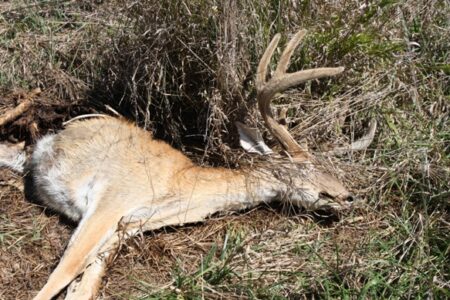Historians believe that nearly 30 million whitetails existed across about 80% of the U.S. before its discovery by European. The mule deer range was about half that size, and their numbers were estimated about one-third that of whitetails. North America’s forests, mountains and deserts thrived with deer before white man’s arrival. By the end of the 1900s, these magnificent animals had declined to a status of endangered. How could this have happened?
Declining Deer Population: Overhunting and Disease
The pre-colonization buffalo herds were also estimated to be around 30 million. Throughout the 1800s, buffalo were needlessly slaughtered and their population dropped to less than 2,000. With bison gone and cattle production not yet keeping up with immigration and the human population boom, deer were intensely targeted by meat hunters. Killed by the wagonloads, the U.S. deer herd dwindled to 1/60th of its 15th-century population.
The yesteryear disappearance of deer is mainly blamed on overhunting; however, the period of vanishing populations also paralleled the end of the Little Ice Age. This documented 300-year period of severe cold weather, suspected to end about 1850, impacted agriculture, health, economics, social life, emigration, and even art and literature (Google “Little Ice Age”). Earth’s continual rising temperature after this historic era of subzero weather caused the upsurge of deadly viral diseases in mammals.
Episodic Hemorrhagic Disease in Whitetail Deer
Warmer weather proliferated the rise of a viral infection in deer dubbed Episodic Hemorrhagic Disease (EHD), interrelated to Blue Tongue (BT). It was first documented in 1886 and again in 1901 on a northern section of the Missouri River when whitetails were found dead along this large tributary of the Mississippi. The last century-and-a-half-plus trend toward earlier springs, less rain in summer and fall, and warmer winters accelerated this deer disease.
This lethal virus is carried by a tiny biting fly called a midge. Its larvae live in mud along any stream or pooled water. When it pupates and emerges during dry years, infected adults fly off and bite deer, transferring the disease. After the disease is contracted, a perfectly healthy deer usually dies within 8 to 10 days. It’s speculated that eventual immunity in deer cannot be attained due to sporadic outbreaks controlled by the inconsistency of drought years.
Symptoms include loss of appetite and weight, weakness, escalated pulse and respiration rates, and fever and hemorrhaging forces the infected animal to water. A swollen tongue, bluish in color due to insufficient blood oxygen, will not allow swallowing in the case of Blue Tongue. Often, an infected deer beds down in water to reduce body temperature and passes into a shock-like state, dying within a day or two after the initial symptoms appear. EHD victims may die away from water when their blood veins rupture.
Though the adult midge lives only about a month, the larvae can survive in mud a year; it thrives on decaying organic matter until surfacing as an adult. Only sub-freezing weather for extended periods during winter can put frost deep enough to help kill the larvae. We have not had this kind of frost depth for many years, and this has caused increasing EHD and BT deaths. Whether you believe in “global warming” or “weather trend” for earth’s rising temperatures, this documented warming period has caused disease-carrying insects to greatly multiply their numbers.
It is very suspect that the disappearance of deer by the late 1800s was a combination of overhunting and disease. The closing of continental deer hunting and sound wildlife management throughout the early 1900s, of course, brought deer herds back to a huntable status. But are they in trouble again? The answer is clearly “yes.” Would it be a fictional doomsday prediction to say that poor deer management and disease could nearly wipe out an entire county’s deer herd? I think not.
Poor Wildlife Management of Deer Population
Unfortunately, individual state deer management, once based in science, has now grown to be political. Influenced by farm agency and insurance company lobbyists, legislators regularly appoint natural resources directors who are not faithful guardians of wildlife. One of the poorest-managed deer herds, in my opinion, is in my home state of Illinois. The Illinois Department of Natural Resources has allowed deer in this state to be overhunted; it’s also turned a blind eye to the ongoing EHD/BT epidemic. A group known as the Illinois Whitetail Alliance formed early this year to help turn this situation around (join free at the Illinois Whitetail Alliance website).
Conversely, Ohio, by far, is the best-managed deer state in the U.S. Its wildlife administrators assess the deer herd very regionally — by county — and perform regular hunter surveys to establish population accuracy and the effects of disease before annual permit allocation. Bravo to them!
Whether you’re a hunter or simply a nature lover, get involved in your state’s deer management. It would be inconceivable to lose such a wonderful natural resource as deer. Their majestic beauty and grace would be profoundly missed!







